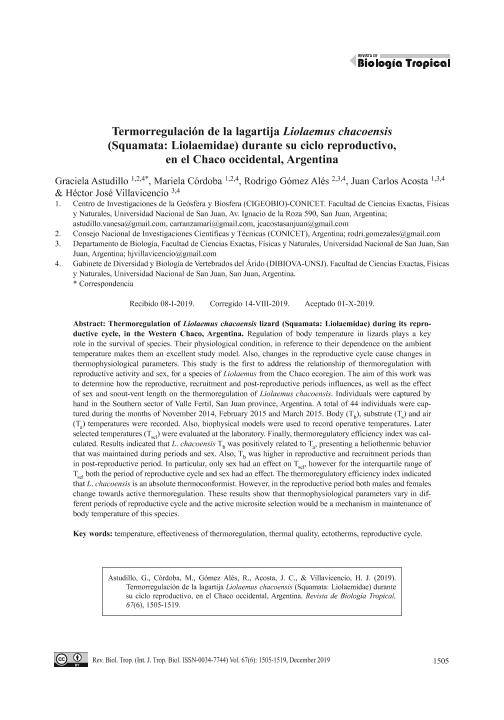Mostrar el registro sencillo del ítem
dc.contributor.author
Astudillo, Graciela Vanesa

dc.contributor.author
Córdoba, Mariela Analía

dc.contributor.author
Gómez Alés, Carlos Rodrigo

dc.contributor.author
Acosta, Juan Carlos
dc.contributor.author
Villavicencio Martin, Hector Jose

dc.date.available
2021-02-05T12:17:47Z
dc.date.issued
2019-10
dc.identifier.citation
Astudillo, Graciela Vanesa; Córdoba, Mariela Analía; Gómez Alés, Carlos Rodrigo; Acosta, Juan Carlos; Villavicencio Martin, Hector Jose; Termorregulación de la lagartija Liolaemus chacoensis (Squamata: Liolaemidae) durante su ciclo reproductivo, en el Chaco occidental, Argentina; Revista de Biología Tropical; Revista de Biología Tropical; 67; 6; 10-2019; 1505-1519
dc.identifier.issn
0034-7744
dc.identifier.uri
http://hdl.handle.net/11336/124923
dc.description.abstract
Regulation of body temperature in lizards plays a key role in the survival of species. Their physiological condition, in reference to their dependence on the ambient temperature makes them an excellent study model. Also, changes in the reproductive cycle cause changes in thermophysiological parameters. This study is the first to address the relationship of thermoregulation with reproductive activity and sex, for a species of Liolaemus from the Chaco ecoregion. The aim of this work was to determine how the reproductive, recruitment and post-reproductive periods influences, as well as the effect of sex and snout-vent length on the thermoregulation of Liolaemus chacoensis. Individuals were captured by hand in the Southern sector of Valle Fertil, San Juan province, Argentina. A total of 44 individuals were captured during the months of November 2014, February 2015 and March 2015. Body (Tb), substrate (Ts) and air (Ta) temperatures were recorded. Also, biophysical models were used to record operative temperatures. Later selected temperatures (Tsel) were evaluated at the laboratory. Finally, thermoregulatory efficiency index was calculated. Results indicated that L. chacoensis Tb was positively related to Ta, presenting a heliothermic behavior that was maintained during periods and sex. Also, Tb was higher in reproductive and recruitment periods than in post-reproductive period. In particular, only sex had an effect on Tsel, however for the interquartile range of Tsel both the period of reproductive cycle and sex had an effect. The thermoregulatory efficiency index indicated that L. chacoensis is an absolute thermoconformist. However, in the reproductive period both males and females change towards active thermoregulation. These results show that thermophysiological parameters vary in different periods of reproductive cycle and the active microsite selection would be a mechanism in maintenance of body temperature of this species.
dc.format
application/pdf
dc.language.iso
spa
dc.publisher
Revista de Biología Tropical

dc.rights
info:eu-repo/semantics/openAccess
dc.rights.uri
https://creativecommons.org/licenses/by-nc-sa/2.5/ar/
dc.subject
ECTOTHERMS
dc.subject
EFFECTIVENESS OF THERMOREGULATION
dc.subject
REPRODUCTIVE CYCLE
dc.subject
TEMPERATURE
dc.subject
THERMAL QUALITY
dc.subject.classification
Conservación de la Biodiversidad

dc.subject.classification
Ciencias Biológicas

dc.subject.classification
CIENCIAS NATURALES Y EXACTAS

dc.title
Termorregulación de la lagartija Liolaemus chacoensis (Squamata: Liolaemidae) durante su ciclo reproductivo, en el Chaco occidental, Argentina
dc.title
Thermoregulation of Liolaemus chacoensis lizard (Squamata: Liolaemidae) during its reproductive cycle, in the Western Chaco, Argentina
dc.type
info:eu-repo/semantics/article
dc.type
info:ar-repo/semantics/artículo
dc.type
info:eu-repo/semantics/publishedVersion
dc.date.updated
2020-11-19T21:43:58Z
dc.journal.volume
67
dc.journal.number
6
dc.journal.pagination
1505-1519
dc.journal.pais
Costa Rica

dc.journal.ciudad
Turrialba
dc.description.fil
Fil: Astudillo, Graciela Vanesa. Consejo Nacional de Investigaciones Científicas y Técnicas. Centro Científico Tecnológico Conicet - San Juan. Centro de Investigaciones de la Geosfera y Biosfera. Universidad Nacional de San Juan. Facultad de Ciencias Exactas Físicas y Naturales. Centro de Investigaciones de la Geosfera y Biosfera; Argentina
dc.description.fil
Fil: Córdoba, Mariela Analía. Consejo Nacional de Investigaciones Científicas y Técnicas. Centro Científico Tecnológico Conicet - San Juan. Centro de Investigaciones de la Geosfera y Biosfera. Universidad Nacional de San Juan. Facultad de Ciencias Exactas Físicas y Naturales. Centro de Investigaciones de la Geosfera y Biosfera; Argentina
dc.description.fil
Fil: Gómez Alés, Carlos Rodrigo. Universidad Nacional de San Juan. Facultad de Ciencias Exactas Físicas y Naturales. Departamento de Biología; Argentina. Consejo Nacional de Investigaciones Científicas y Técnicas. Centro Científico Tecnológico Conicet - San Juan; Argentina
dc.description.fil
Fil: Acosta, Juan Carlos. Universidad Nacional de San Juan. Facultad de Ciencias Exactas Físicas y Naturales. Departamento de Biología; Argentina. Consejo Nacional de Investigaciones Científicas y Técnicas. Centro Científico Tecnológico Conicet - San Juan. Centro de Investigaciones de la Geosfera y Biosfera. Universidad Nacional de San Juan. Facultad de Ciencias Exactas Físicas y Naturales. Centro de Investigaciones de la Geosfera y Biosfera; Argentina
dc.description.fil
Fil: Villavicencio Martin, Hector Jose. Universidad Nacional de San Juan. Facultad de Ciencias Exactas Físicas y Naturales. Departamento de Biología; Argentina. Consejo Nacional de Investigaciones Científicas y Técnicas. Centro Científico Tecnológico Conicet - San Juan; Argentina
dc.journal.title
Revista de Biología Tropical

dc.relation.alternativeid
info:eu-repo/semantics/altIdentifier/url/https://revistas.ucr.ac.cr/index.php/rbt/article/view/35835/40162
dc.relation.alternativeid
info:eu-repo/semantics/altIdentifier/doi/http://dx.doi.org/10.15517/rbt.v67i6.35835
Archivos asociados
